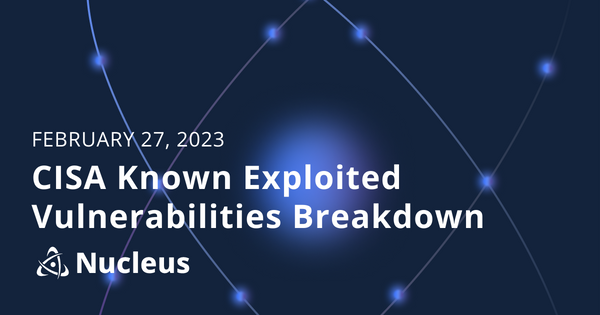February 27, 2023 CISA KEV Breakdown | ZK Framework

February 27 – 1 New Vuln | CVE-2022-36537
In this CISA KEV Breakdown, a single vulnerability in the Java ZK Framework which can allow for code execution was added to the KEV after hundreds of servers had backdoors implanted following the disclosure of a proof of concept.
wpDataTable with provided ID not found!Notable Vulnerability Additions
CVE-2022-36537 | Remote Code Execution
A vulnerability initially discovered as information leakage but further resulted in remote code execution exists in the Java ZK Framework before versions 8.6.4.1, 9.0.1.2, 9.5.1.3, 9.6.0.1, and 9.6.1. It was realized the vulnerability, chained with existing technology in which it exists, was capable of RCE and implanting a backdoor once Huntress researchers disclosed in a report that they were able to take existing proof-of-concept code and utilize it to later achieve device takeover and the spreading of Lockbit 3.0 in a demo environment utilizing R1Soft Server Backup Manager. The vulnerability exists due to a specially crafted POST request that can lead to information leakage of sensitive files normally hidden to the user. Existing proof-of-concept code exists on the internet, and an existing report from Fox IT indicates there were hundreds of open-facing R1Soft servers in which a backdoor was implemented.
While the vulnerability itself is not capable of supply chain RCE, where a vulnerability exists and how a piece of software uses the technology in which it exists could potentially allow for outcomes such as the above.
Security Advisory:
https://tracker.zkoss.org/browse/ZK-5150
Be sure to check out Nucleus Security’s KEV Enrichment Dashboard where we overlay vulnerabilities that are added to the catalog with intelligence from GreyNoise, exploit-prediction scoring from EPSS and lastly CVSS. You can use the data yourself and use further metrics to influence decision-making when determining risk of vulnerabilities added to the KEV.
← February 21, 2023 CISA Kev Breakdown
Click here to expand our CISA KEV Breakdown Frequently Asked Questions
- What makes for a notable addition?
- A notable addition can arise from many different characteristics. If a particular vulnerability is notable to the security community or a subset of the security community or if the EPSS score reveals notable information about the vulnerability, this can constitute further analysis. It may also be the case that a particular vulnerability shines a light on everyday users and we will highlight important information and key takeaways to ensure users and readers have easy access to actionable information.
- When is the Breakdown released?
- We aim to have our analysis of each KEV update posted within 24 hours of the time in which the Catalog is updated. See CISA’s full catalog here
- I am not bound by BOD 22-01 or federal regulations, why should the KEV concern me?
- CISA encourages all organizations to utilize the Catalog as an attribute in your vulnerability prioritization framework. Organizations looking to lessen the scope on known dangerous vulnerabilities and make a goal to remediate them can understand where they currently stand against what CISA has confirmed as exploited vulnerabilities in the wild. See CISA’s section on “How should organizations use the KEV catalog?” here.
- What is EPSS?
- EPSS is the Exploit Prediction Scoring System. It is an open, data-driven effort for estimating the likelihood (probability) that a software vulnerability will be exploited in the wild. See the EPSS home page on FIRST for more information here.
- What is the difference between EPSS probability and EPSS percent?
- EPSS probability is the risk calculated by the model when determining the perceived threat of the vulnerability itself. Percentage is a relative comparison of the rest of the CVEs within the given sample. While the probability only changes upon refreshing the results from the model, the percentage can change purely based on the CVE sample given. In the case of the Breakdown, we use the percentage given by the pool of all CVEs with given EPSS data. Scores may vary post-release of the post given new information about the vulnerabilities and their perceived threat. For more information on applying and understanding EPSS data, see this article on the FIRST website, as well as their FAQ page.
- What is GreyNoise?
- GreyNoise is a platform that collects, analyzes, and labels data on IPs that scan the internet and saturate security tools with noise. Through their sensor network, GreyNoise observes vulnerability exploitation attempts for vulnerabilities that are exploited in the wild over the Internet. These are arguably vulnerabilities that should be at the very top of your priority list to remediate.
- Why are GreyNoise exploitation attempts only observed on ~20% of KEV vulnerabilities?
- Exploitation of many vulnerabilities in the CISA KEV will not be observed for many reasons that GreyNoise does a good job of explaining in this post. For example:
- The vulnerability may not be remotely exploitable
- Vulnerability exploitation may require authentication (and result in privilege escalation)
- The impacted software may not be exposed to the internet
- Mass scanning/exploitation is not occurring yet
- Exploitation of many vulnerabilities in the CISA KEV will not be observed for many reasons that GreyNoise does a good job of explaining in this post. For example:
See Nucleus in Action
Discover how unified, risk-based automation can transform your vulnerability management.






























